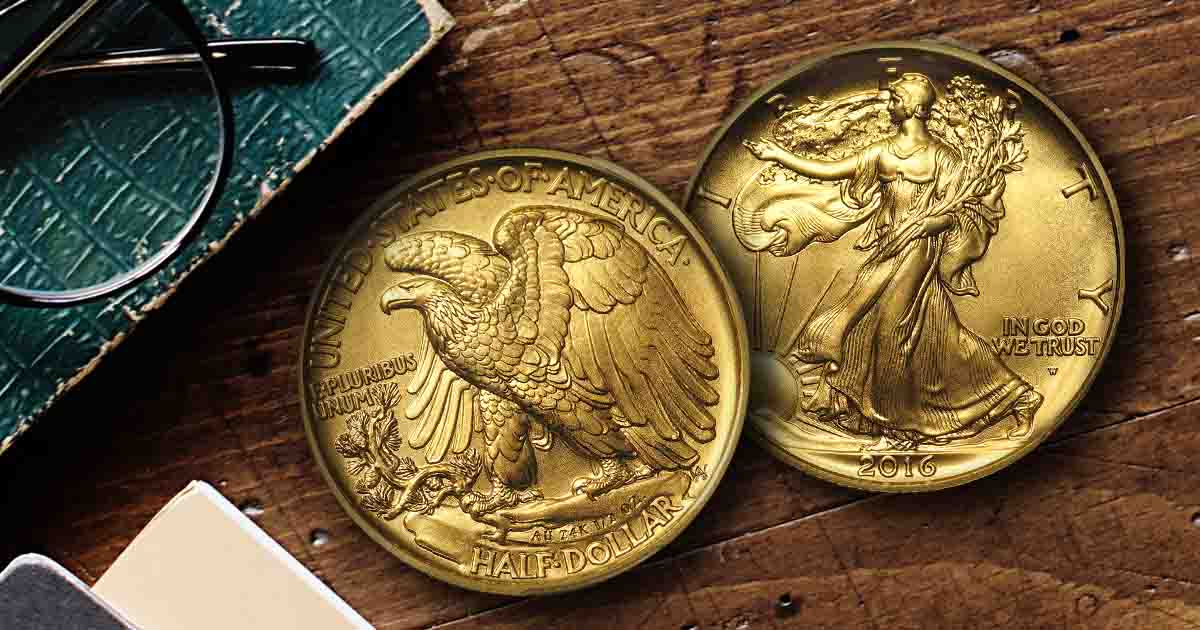
In 2016, the United States Mint issued a gold Walking Liberty half-dollar coin to commemorate the centennial of this design by Adolph A. Weinman.
Why was the Walking Liberty Half Dollar Reissued?
The Walking Liberty half dollar was reissued as a gold commemorative coin through the United States Mint Centennial Gold Coin Program. It was produced at the West Point branch of the U.S. Mint in a limited mintage of 65,512 coins and weighs 15.55 grams. Other coins that were reissued in gold to celebrate the 100-year anniversary of their issue were the Mercury Dime Centennial and Standing Liberty Centennial.
The gold content of the Centennial releases is symbolic of the denomination of the original coin: The Mercury, or Winged Liberty design had been issued as a dime and the centennial issue had 1/10 ounce of .9999 fine gold. The Standing Liberty design had been issued as a quarter dollar, and its centennial release had 1/4 ounce of .9999 fine gold. Similarly, the Walking Liberty was issued as a half dollar, and its centennial issue had 1/2 ounce of .9999 fine gold, although the coins list the metal as AU 24K.
List of 2016 Centennial Gold Releases
| Issue | Face Value | Gold Content |
| Mercury Dime Centennial | $0.10 | 1/10 Ounce Fine Gold |
| Standing Liberty Centennial | $0.25 | ¼ Ounce Find Gold |
| Walking Liberty Centennial | $0.50 | ½ Ounce Fine Gold |
History of the Walking Liberty Half Dollar
The Walking Liberty half dollar was produced as a constitutional silver coin from 1916 until 1947.
What Precipitated Weinman’s Design?
Its origins date to 1915, when Robert Wickliffe Woolley was in the first of his two years as Director of the U.S. Mint. Woolley saw the 25-year minimum issuance of United States coins as a requirement to replace circulating coins every quarter century. At the time, Charles Barber designed coins had been struck since 1892, including the dime, quarter, and half dollar. Although Barber coins may be seen favorably in the contemporary numismatic world, the American public responded to them with considerable dissatisfaction when they were released and circulating. Despite this, Woolley first asked then-Chief Mint Engraver Charles E. Barber to prepare new designs on April 14, 1915. In December of that year, both Woolley and Barber appeared before U.S. Congress to share Mint sketches for new coins, at which time Woolley suggested that Congress may choose different sculptors to submit designs.
Adolph A. Weinman’s Walking Liberty Half Dollar
At Mint Director Robert W. Woolley’s behest, the Commission of Fine Arts held a design contest, and sculptors met with Woolley in New York City on February 23, 1916. Initially, Weinman’s designs were chosen for the half dollar, dime, and reverse of the quarter dollar. Weinman’s competitors were designers Hermon MacNeil and Albin Polasek- The Commission had only invited three designers to submit proposals.
Weinman made revisions to his designs through the Spring of 1916 and, after recovering from a case of tonsillitis, submitted his final designs to the Mint on May 29 of that year. Barber made changes to the design, some of which were felt unnecessary by Weinman and Mint staff, who overcame striking difficulties by adjusting the relief and better preparing coin blanks. Although adjustments helped the strikes, many Walking Liberty half dollars feature poor strikes. The San Francisco Mint branch had an especially difficult time producing quality strikes, and the Walking Liberty half dollar was replaced by the Franklin half dollar in 1948.




